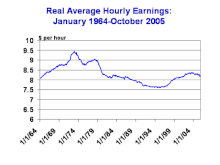Wage
| Part of a series on |
| Economics |
|---|
| Personal finance |
|---|
 |
|
Credit · Debt |
| Employment contract |
| Retirement |
|
| Personal budget and investment |
| See also |
A wage is payment made by an
Payment by wage contrasts with salaried work, in which the employer pays an arranged amount at steady intervals (such as a week or month) regardless of hours worked, with commission which conditions pay on individual performance, and with compensation based on the performance of the company as a whole. Waged employees may also receive tips or gratuity paid directly by clients and employee benefits which are non-monetary forms of compensation. Since wage labour is the predominant form of work, the term "wage" sometimes refers to all forms (or all monetary forms) of employee compensation.
Origins and necessary components
- The very idea of wage-labour requires two difficult conceptual steps. First it requires the abstraction of a man's labour from both his person and the product of his work. When one purchases an object from an independent craftsman ... one has not bought his labour but the object, which he had produced in his own time and under his own conditions of work. But when one hires labour, one purchases an abstraction, labour-power, which the purchaser then uses at a time and under conditions which he, the purchaser, not the "owner" of the labour-power, determines (and for which he normally pays after he has consumed it). Second, the wage labour system requires the establishment of a method of measuring the labour one has purchased, for purposes of payment, commonly by introducing a second abstraction, namely labour-time.[1]
The wage is the monetary measure corresponding to the standard units of working time (or to a standard amount of accomplished work, defined as a
Wages were paid in the
Determinants of wage rates
Depending on the structure and traditions of different economies around the world, wage rates will be influenced by market forces (supply and demand), labour organisation, legislation, and tradition. Market forces are perhaps more dominant in the United States, while tradition, social structure and seniority, perhaps play a greater role in Japan.[12][citation needed]
Wage differences
Even in countries where market forces primarily set wage rates, studies show that there are still differences in remuneration for work based on sex and race. For example, according to the
Effects
Corruption
It is known that the wage level of employees in the public sector affects the frequency of corruption, and that higher salary levels for public sector workers help reduce corruption. It has also been shown that countries with smaller wage gaps in the public sector have less corruption. [15]
Wages in the United States

Seventy-five million workers earned hourly wages in the United States in 2012, making up 59% of employees.

In the second quarter of 2022, the total U.S. labor costs grew up 5.2% year over year, the highest growth since the starting point of the serie in 2001.[19]
Definitions
For purposes of federal income tax withholding, 26 U.S.C. § 3401(a) defines the term "wages" specifically for chapter 24 of the Internal Revenue Code:
"For purposes of this chapter, the term “wages” means all remuneration (other than fees paid to a public official) for services performed by an employee for his employer, including the cash value of all remuneration (including benefits) paid in any medium other than cash;" In addition to requiring that the remuneration must be for "services performed by an employee for his employer," the definition goes on to list 23 exclusions that must also be applied.[20]
See also
- Compensation of employees
- Employee benefit(non-monetary compensation in exchange for labor)
- Employment
- Labour economics
- List of countries by average wage
- Performance-related pay
- Wage labour
- Wage share
- Real wages
- List of sovereign states in Europe by net average wage
- Marginal factor cost
- Overtime
Political science:
- Labour power
- Proletarian
- Working class
- Wage slavery
References
- ISBN 9780520024366.
- JSTOR 649749.
- ISBN 9780226155104.
- S2CID 143251928.
- ^ ISBN 9780520024366.
- ISBN 0-684-19279-9.
- ^ Hammurabi (1903). "Code of Hammurabi, King of Babylon". Records of the Past. 2 (3). Translated by Sommer, Otto. Washington, DC: Records of the Past Exploration Society: 85. Retrieved June 20, 2021.
234. If a shipbuilder builds ... as a present [compensation].
- ^ Hammurabi (1904). "Code of Hammurabi, King of Babylon" (PDF). Liberty Fund. Translated by Harper, Robert Francis (2nd ed.). Chicago: University of Chicago Press. p. 83. Retrieved June 20, 2021.
§234. If a boatman build ... silver as his wage.
- ^ a b Hammurabi (1910). "Code of Hammurabi, King of Babylon". Avalon Project. Translated by King, Leonard William. New Haven, CT: Yale Law School. Retrieved June 20, 2021.
- ^ Hammurabi (1903). "Code of Hammurabi, King of Babylon". Records of the Past. 2 (3). Translated by Sommer, Otto. Washington, DC: Records of the Past Exploration Society: 88. Retrieved June 20, 2021.
275. If anyone hires a ... day as rent therefor.
- ^ Hammurabi (1904). "Code of Hammurabi, King of Babylon" (PDF). Liberty Fund. Translated by Harper, Robert Francis (2nd ed.). Chicago: University of Chicago Press. p. 95. Retrieved June 20, 2021.
§275. If a man hire ... its hire per day.
- ^ "Student Login". Edgenuity. – Education 2020 Homeschool console, Vocabulary Assignment, definition entry for "wage rate" (may require login to view)
- ^ Magnusson, Charlotta. "Why Is There A Gender Wage Gap According To Occupational Prestige?." Acta Sociologica (Sage Publications, Ltd.) 53.2 (2010): 99-117. Academic Search Complete. Web. 26 Feb. 2015.
- ^ U.S. Bureau of Labor Statistics. "Earnings of Women and Men by Race and Ethnicity, 2007" Accessed June 29, 2012
- ^
Asli Demirgüç-Kunt, Michael Lokshin, Vladimir Kolchin (8 April 2023). "Effects of pulic sector wages on corruption: Wage inequality matters". Journal of Comparative Economics.
{{cite web}}: CS1 maint: multiple names: authors list (link) - ^ "Employees" as a category excludes all those who are self-employed, and this statistics only considers workers over the age of 16. U.S. Department of Labor. Bureau of Labor Statistics (2013-02-26), Characteristics of Minimum Wage Workers: 2012
- ^ Tennant, Michael. "Minimum Wage The Ups & Downs." New American (08856540) 30.12 (2014): 10-16. Academic Search Complete. Web. 26 Feb. 2015.
- ^ "Living Wage Calculator". livingwage.mit.edu. Retrieved 2023-10-02.
- ^ Aeppel, Timothy (August 29, 2022). "North American companies send in the robots, even as productivity slumps". Reuters.
- ^ USC 26 § 3401(a)
Further reading
- Galbraith, James Kenneth. Created Unequal: the Crisis in American Pay, in series, Twentieth Century Fund Book[s]. New York: Free Press, 1998. ISBN 0-684-84988-7
External links
- U.S. Bureau of Labor Statistics
- Wealth of Nations – click Chapter 8
- U.S. Department of Labor: Minimum Wage Laws – Different laws by State
- Average U.S. farm and non-farm wage
- Prices and Wages by Decade library guide – Prices and Wages research guide at the University of Missouri libraries
